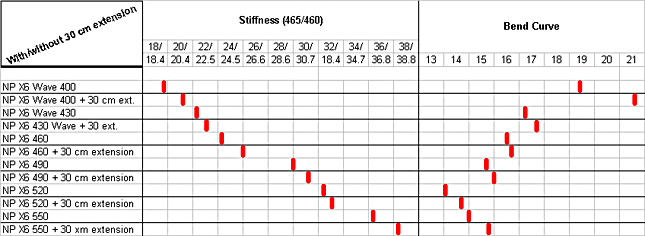|
Comparing the masts with the next smaller mast in the line-up, extended by 30 cm.
Put a little more understandably we're talking about: The X6 400 cm + 30 cm extension versus the X6 430 cm mast. The X6 430 cm + 30 cm extension versus the X6 460 cm mast. The X6 460 cm + 30 cm extension versus the X6 490 cm mast. The X6 490 cm + 30 cm extension versus the X6 520 cm mast. The X6 520 cm + 30 cm extension versus the X6 550 cm mast.
The extension used is a 50.5 cm long aluminum extension, leaving 20.5 cm up inside the masts.
As "usual" the results are divided into two charts - one with the exact figures and a presentation that is slightly easier to extract the results from - but telling the same story.
|
|
|
|
|
|
A few comments:
Stiffness.
As you can see, the "parent" masts gradually grow stiffer with length - just with a larger-than-expected "jump" between the X6 460 and the X6 490 (mentioned in the 460/490 pairing). When fitted with a 30 cm extension, the stiffness of the (now extended) masts of course fall in between the stiffness of the parent mast and the next larger mast in the line-up. However, it's also a clear tendency, that the extended mast is a little closer in stiffness to the parent mast than to the next larger mast in the line-up. For instance, the X6 460 mast has a stiffness of IMCS 23.3, and the X6 490 mast has a stiffness of IMCS 29 - and when the 460 mast is extended with 30 cm, it ends up closer to the 460 cm mast than the 490 cm mast (IMCS 25 that is).
Bend Curve.
Compared to the parent mast it's a general tendency, that when you extend a X6 mast (and every other mast for that matter) it grows a little more in relatively softness in the top. Except for the extended X6 400 cm mast the 30 cm extension induces a growth of less than 1 point in bend curve, so perhaps you can talk about an almost negligible change.
For the extended X6 400 cm mast the change towards a relatively softer top amounts to approx. 2 points. A (part) reason for this larger sensibility to extension probably lies in the fact, that a 30 cm is a proportionally larger extension with a 400 mast (7.5%) than with, say, a 520 cm mast (5.8%).
By comparing the bend curve of the extended mast with the bend curve of the next larger mast in the line-up, you actually combine two tendencies: Firstly the tendency for shorter masts to be relatively softer in the tops than the next longer mast in the line-up, and secondly the tendency for extended masts to grow a little relatively softer in the tops. The two tendencies kind of compliment each other, and consequently the extended masts generally have somewhat more bend curve than the equally long non-extended masts.
Two masts bring a little disorder in the line-up - the X6 400 and the X6 520:
The X6 400 is very Flex Top, and the extended 400 cm mast consequently ends up with a lot more bend curve than the 430 cm mast (more than 4 points in difference). As a side-note this very big difference might be a little surprising, in light of some of the arguing over the years, about whether it's best to use a X6 430 mast with your NP wave-sail around the 5.4 size - or it's best to use the sails with an X6 400 mast extended. Bend curve wise these mast options are so departed, that their performances probably shouldn't be similar ...
As for the X6 520, it's by far the X6 mast closest to Constant Curve, and strictly the extended 520 cm mast in fact ends up with less bend curve than the 550 cm mast. Well, in practical sense they have almost the same bend curve, and the question whether to use a X6 520 extended or a X6 550 is consequently confined to a matter of stiffness.
|

